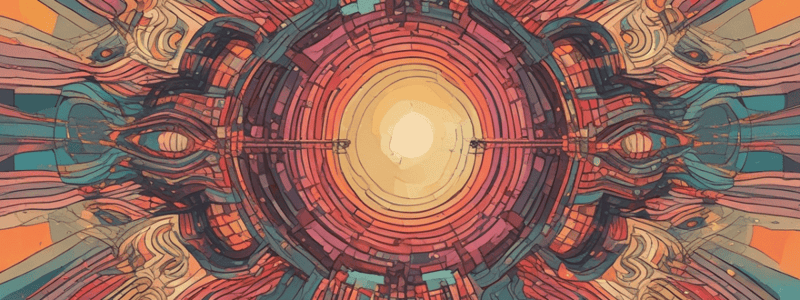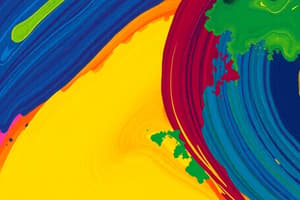Podcast
Questions and Answers
What is the common theme among all color theories?
What is the common theme among all color theories?
- The symbolism of color in different cultures
- The study of mixing colors
- The meanings of different colors
- The reactions of the eye to color combinations (correct)
What is red often associated with?
What is red often associated with?
- Strong emotions such as love and anger (correct)
- Nature and the environment
- Technology and innovation
- Peace and calmness
What is pink often associated with?
What is pink often associated with?
- Nature and the outdoors
- Love, tranquility, and femininity (correct)
- Passion and energy
- Power and strength
What is a common use of the color red?
What is a common use of the color red?
What is a positive connotation of the color red?
What is a positive connotation of the color red?
What is the origin of the phrase 'red-letter day'?
What is the origin of the phrase 'red-letter day'?
What is a negative connotation of the color red?
What is a negative connotation of the color red?
Why should red be used carefully?
Why should red be used carefully?
What is associated with the color pink?
What is associated with the color pink?
What is the name of the specific shade of pink that reduces hostile behavior?
What is the name of the specific shade of pink that reduces hostile behavior?
What emotion does the color orange convey?
What emotion does the color orange convey?
What is the effect of the color yellow on the brain?
What is the effect of the color yellow on the brain?
What is a negative association of the color yellow?
What is a negative association of the color yellow?
What is the effect of the color orange on appetite?
What is the effect of the color orange on appetite?
What is a positive association of the color orange?
What is a positive association of the color orange?
What is the reason why yellow is often used as a warning sign?
What is the reason why yellow is often used as a warning sign?
What is the minimum number of requirements needed for color to occur?
What is the minimum number of requirements needed for color to occur?
What is the term for the color impression that we see?
What is the term for the color impression that we see?
What determines the color effect of an object?
What determines the color effect of an object?
What is the range of the visible spectrum?
What is the range of the visible spectrum?
What is the term for the distance between peaks of light energy emissions?
What is the term for the distance between peaks of light energy emissions?
What is the unit of measurement for wavelengths of light?
What is the unit of measurement for wavelengths of light?
What is the term for two objects that appear to match under one light source but not under another?
What is the term for two objects that appear to match under one light source but not under another?
What factor in perception includes the conditions under which the color is perceived?
What factor in perception includes the conditions under which the color is perceived?
What is the term used to describe the ability to detect differences between wavelengths of light?
What is the term used to describe the ability to detect differences between wavelengths of light?
What is the point at which an individual can no longer detect a difference between two close samples?
What is the point at which an individual can no longer detect a difference between two close samples?
What is the term used to describe the use of conflicting, unrelated colors?
What is the term used to describe the use of conflicting, unrelated colors?
What is the main cause of color blindness in the vast majority of people?
What is the main cause of color blindness in the vast majority of people?
What is the term used to describe the impression of transparency achieved by joining two sets of color with a third that is perfectly balanced between them?
What is the term used to describe the impression of transparency achieved by joining two sets of color with a third that is perfectly balanced between them?
What is the term used to describe colors that are generally regarded as more advancing as they become?
What is the term used to describe colors that are generally regarded as more advancing as they become?
What affects the way a color's impact can vary from individual to individual?
What affects the way a color's impact can vary from individual to individual?
What is the goal of Color Competence?
What is the goal of Color Competence?
What is the term used to describe a series of progressive intervals that are so close that individual steps cannot be distinguished?
What is the term used to describe a series of progressive intervals that are so close that individual steps cannot be distinguished?
What is the term for undiluted colors?
What is the term for undiluted colors?
What is the term used to describe the visual agreement of all parts of a work?
What is the term used to describe the visual agreement of all parts of a work?
What is a characteristic of a chromatic scale?
What is a characteristic of a chromatic scale?
What is the term used to describe any of a range of combinations of colors in which a style or design is available?
What is the term used to describe any of a range of combinations of colors in which a style or design is available?
What is the term for a combination of unequal proportions of all the primaries?
What is the term for a combination of unequal proportions of all the primaries?
What is an example of a color found in nature?
What is an example of a color found in nature?
What is the purpose of Eye Training in color study?
What is the purpose of Eye Training in color study?
Flashcards are hidden until you start studying
Study Notes
Color Theory
- All color theories have one significant thing in common: the eye and its reactions to color combinations.
- Color theorists attempted to create a single system to encompass all variables, but no single system can answer all the needs of color theory due to the diverse forms of color usage.
Color Meanings
- Red:
- One of the oldest color names, associated with passion, drama, and strong emotions.
- Attracts the most attention, symbolizes danger, courage, strength, and power.
- Stimulates desire, linked to sexuality and increased appetites.
- Represents luck and prosperity in Chinese culture.
- Pink:
- Associated with love, tranquility, and femininity.
- A combination of the passion of red and the purity of white.
- Conveys tenderness, nurturing, and safety, but can also be seen as unrealistic and overly optimistic.
- Orange:
- The color of encouragement, conveying excitement, warmth, and enthusiasm.
- Social and inviting, stimulating appetite, and associated with healthy goods.
- Motivating and encouraging, appealing to young people.
- Yellow:
- Most easily perceived hue with the highest luminosity rating after white.
- Associated with optimism, youthful, fresh energy, success, and confidence.
- Stimulates the left side of the brain, helping with clear thinking and quick decision-making.
How We See Color
- Color is a mental sensation that requires an observer, an object, and sufficient light in the visible spectrum.
- Light sources emit visible energy in pulses or waves, which are measured in nanometers.
- The colored light in the visible spectrum ranges from red to violet.
- Factors in perception include light quality, metamerism, and matching.
Color Systems
- Partitive Color: based on the viewer's reaction to colors when placed next to each other.
- Subtractive Color: the process of mixing pigments together, as seen in paintings.
Psychology and Culture
- Memories, experiences, intelligence, and cultural background affect the impact of color on an individual.
- Color study involves eye training, color control, and color competence.
Color Terms
- Dimensions of Color:
- Hue: undiluted colors, permitting classification as red, yellow, green, blue, or an intermediate color.
- Chromatic: having hue, polychromatic: having many hues, monochromatic: having one hue only.
- Prismatic: use of pure hues only.
- Broken Hue: a combination of unequal proportions of all the primaries.
- Chromatic Scale: a linear series of hues in spectrum order, illustrating pure saturated colors or more complex, diluted colors.
Studying That Suits You
Use AI to generate personalized quizzes and flashcards to suit your learning preferences.




